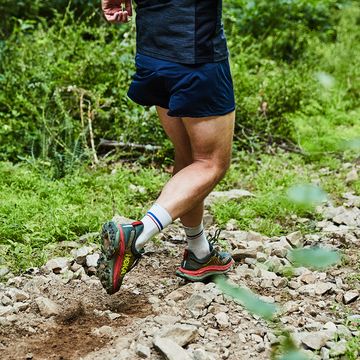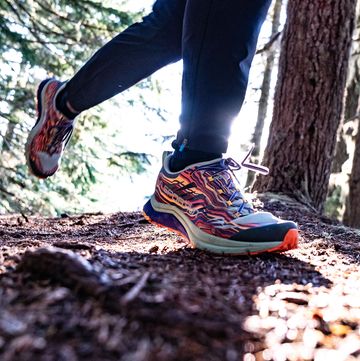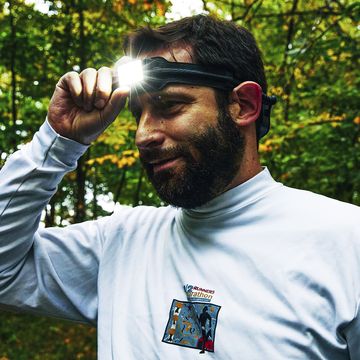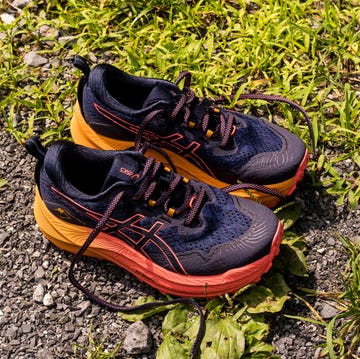Although trail running can be similar to running on the roads, there are some differences to make note of before you hit the trailhead. To help you get started, we pulled together a list of our best trail running tips that will help every level of runner.
Most importantly, have fun on the trails, and be safe. But fair warning: They say that once you go to the dirt, you never go back.
→ No single trail is the same
Every trail has its own unique terrain and challenge. There are groomed trails that are wide, limestone-based, and often even in surface, which make for a great introduction to running off the road. And there are narrow “singletrack” trails with a variety of obstacles, including tree roots, rocks, sand, hills, mud, and more. Singletrack trails tend to be more challenging, but they offer a dynamic running experience.
→ Leave your ego at home
Running off the road can be exhausting at first, especially in the early stages of training, and it may take you up to twice as long to cover a certain distance on a trail than it would if you were on the road. It’s wise to leave your ego at home, slow your pace, and focus on finding a new rhythm. In a matter of weeks, you’ll be running up hills you used to walk, and you’ll develop a sense of being one with the terrain.
→ Stay safe
When heading out to the trails, bring a buddy or dog, if possible, or tell someone where you plan to run, which trails, and how long you expect to be out. Bring fuel, fluids, a trail map, ID, and cell phone with you for safety, and keep track of where you are along the trail as you go.
If you run alone, download one of these safety apps for your phone or use a device with a safety feature, such as the Apple Watch, and always be mindful of what’s going on around you.
→ Know the rules of the trail
Yield to other trail users (equestrian, hikers, mountain bikers). Generally, downhill runners should yield to uphill runners because the effort to stop and restart on the uphill is greater, and downhill runners often have a better angle of vision. But when in doubt, just be kind and courteous regardless of whether you’re headed up or down. Stay on marked trails and run through puddles, not around them (making the trail wider). Leave no trace, and don’t litter.
→ Keep your eyes on the trail
It can be tempting to gaze at the nature around you, but doing so can quickly lead to tripping and falling. If you want to enjoy the sights, walk it out or stop; otherwise, focus on looking three to four feet ahead to create a line of travel, or where you going to step for the next few strides.
This will keep you focused and in the moment—one of the true gifts of trail running. It’s as much of a physical puzzle as it is a mental one. You will begin to instinctively know where that line is as you become more comfortable running on the trails.
→ Slow down and smell the roses
Running on trails can be a lot more demanding than the roads, especially if it’s a technical singletrack trail with roots, rocks, and other fun obstacles. Don’t compare your road pace to your trail pace, as you will be slower than your normal road-running pace. Instead, develop a trail tempo.
Run by your effort level, by your heart rate, and by the tune of your body. For new trail runners, that may mean walking the hills and running the downhills and flats. No shame in that game. Build up to running the hills slowly, and you’ll prevent injury and burnout along the way.
→ Be mindful of your time
Because the trails are more demanding, it’s wise to run by time at first to gain a sense of your trail pacing versus heading out for a six-miler that might take you 40 minutes longer than expected. Running an out-and-back course is a great way to get to know your pace and develop your trail running confidence. From there, you can develop loops and routes to fit your needs.
→ Change gears
Adjust your pace according to the terrain and maintain a consistent effort level as you climb uphill. When in doubt, walk. Running over downed trees or through mud and sand takes some time getting used to, and it’s best to progress slowly. Tackling obstacles will get easier as your body gets stronger and more seasoned on trails.
→ Wear the right shoes
If you’re going to weave trail running into your life, it’s wise to invest in a pair of trail running shoes. They differ from road-running shoes in that they’re often beefier to handle rugged terrain but also lower profile (lower to the ground), which reduces the chance of ankle rolls with a high heel. The rugged tread offers better traction on muddy, wet trails. They should fit snug in the heel but have room in the toe box.
Once you’ve got ’em, take care of them. After a wet or muddy run, remove the insoles, wash off the mud, and stuff with newspaper or paper towels to dry.
→ Add appropriate accessories
Although many trails provide shaded routes, it’s still wise to wear sunscreen. Sunglasses, dark or light, will protect your eyes from tree branches and bushes. Wearing a hat and bug spray will help prevent insect bites and deter ticks. Grabbing some gaiters will keep the dirt out of your shoes.
→ Carry fluids
Bringing hydration with you on a trail run is a must, as you never know how long it is going to take to complete the workout, or what kind of conditions you may encounter. There are three ways to carry fluids on the run: handheld, multi-bottle waist belt, and hydration pack. Find what works best for you then grab it and go.
→ Trek with poles
For steep, hilly, or mountainous trails, consider using trekking poles to boost aid with balance, reduce wear and tear on your body (four legs are better than two legs), and boost your hill-climbing strength. Using poles reduces the total impact on the knees and hips, and even helps you burn more calories. Plus, you can put rubber pieces on the sticks and use them on the roads, too.
→ Be one with the hill
Take short, quick steps when going up hills and use your arms. Some hills are meant to be walked, especially on the technical trails. Tell your ego that most ultra runners walk the hills and run the downs and flats—it’s a trail thing, and it’s okay to walk (promise)! For gradual downhills on groomed trails, lean into the downhill, open up your stride, and let the hill pull you down.
For technical downhills or steep hills, it’s better to use a stair-stepping motion instead; move in a similar motion as you would running down a flight of stairs, keeping your torso tall and letting your legs to do all the work.
→ Use your arms
Keep your arms (elbows) a little wider for added balance on more technical trails with tree roots and rocks. Your stride is a little different than on the roads because you will need to clear rocks and tree roots and lift your feet a little higher off the ground. You also may need to hop left or right to bypass things on the path like tree branches so pump with your arms as you move to maintain momentum.
→ Practice your trail skills
Just as running intervals will improve your speed, running obstacle repeats on the trail will help create new neuropathways in your brain and boost your technical trail-running skills.
For example, warm up for 10 to 15 minutes, then find a technical stretch of the trail and run repeats, focusing on form and finding your line. Include optimal recovery as you would with a speed interval, start with shorter trail segments (20 to 60 seconds), and build to longer stretches (1 to 3 minutes).
→ Build strength and balance
Another way to improve your trail running performance is to include strength and balance exercises into your regimen two to three times per week, including: lunges,, single-leg squats, bridges, push-ups and dips, deadlifts, calf raises, and using a wobble board or BOSU to develop foot and ankle strength and stability.
→ Ensure proper recovery
It can be tempting to hit the trails frequently at first, but it’s wise to allow for adequate recovery, as trail running—especially hilly, technical runs—will tax your body more than you may feel. When you run hard or long on the roads, you feel it, but when you run hard on the trails, you may not due to the more forgiving terrain. Make sure to weave in trail runs once per week at first, and then progress slowly by adding one trail run per week every two to three weeks.
→ Build up to racing
If you plan to run a trail race, aim to build up to running at least twice a week on trails (50 percent of your runs) and the rest on roads. Balancing the two will allow you to adapt to the new demands of the trail while maintaining the ability to run on harder surfaces without soreness. Start with training on groomed trails, and progress to rugged trails once you have more off-road miles under your belt.
→ Find trails near you
There are a variety of ways to find trails near your home and on your travels. There are several apps available, such as AllTrails, that will show you nearby trails run by other athletes. Or utilize resources such as the Trail Run Project.
You can also connect with local running stores, forest preserves, and national parks to ask about the most commonly used routes. While you’re at it, make sure to ask about the specific nature of the trail, including wild animals, hazards, bathrooms, snakes, spiders, poisonous plants, and anything you may need to know when running in a new area.













